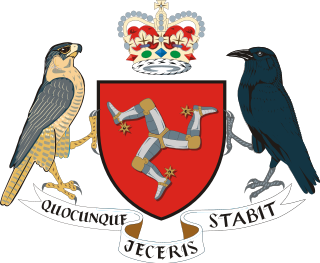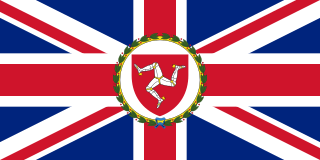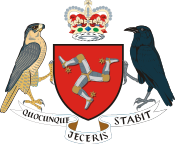
The government of the Isle of Man is a parliamentary representative democracy. The Monarch of the United Kingdom is also the head of state of the Isle of Man, and generally referred to as "The King, Lord of Mann". Legislation of the Isle of Man defines "the Crown in right of the Isle of Man" as separate from the "Crown in right of the United Kingdom". His representative on the island is the Lieutenant Governor of the Isle of Man, but his role is mostly ceremonial, though he does have the power to grant Royal Assent.

Tynwald, or more formally, the High Court of Tynwald or Tynwald Court, is the legislature of the Isle of Man. It consists of two chambers, known as the branches of Tynwald: the directly elected House of Keys and the indirectly chosen Legislative Council. When the two chambers sit together, they become "Tynwald Court".

The Legislative Council is the upper chamber of Tynwald, the legislature of the Isle of Man. The abbreviation "LegCo" is often used.

Tynwald Day is the National Day of the Isle of Man, usually observed on 5 July.

A Deemster is a judge in the Isle of Man. The High Court of Justice of the Isle of Man is presided over by a deemster or, in the case of the appeal division of that court, a deemster and the Judge of Appeal. The deemsters also promulgate the Laws on Tynwald Day by reading out brief summaries of them in English and Manx.

His Honour John Michael Kerruish QC was a Manx lawyer, who was the First Deemster and Clerk of the Rolls on the Isle of Man.

The lowest courts in the Isle of Man are the summary courts, Coroner of Inquests, Licensing Court, Land Court, etc. These courts are presided over by magistrates. There are two stipendiary magistrates, the High Bailiff and the Deputy High Bailiff, along with lay justices of the peace.

David Doyle is a Judge of the Grand Court of the Cayman Islands, Financial Services Division. He was, until 31 July 2018, the First Deemster, Clerk of the Rolls and Deputy Governor of the Isle of Man. He was appointed in 2010 and was formerly a partner of Dickinson Cruickshank & Co from 1985 onwards. He was called to the Bar in 1982 and the Manx Bar in 1984.

Thomas Kneen was His Majesty's Clerk of the Rolls for the Isle of Man, a Member of the House of Keys for Glenfaba, and Captain of the Parish of Onchan.

Sir William Leece Drinkwater was a First Deemster of the Isle of Man.

John Frederick Gill was a Second Deemster of the Isle of Man.

The following outline is provided as an overview of and topical guide to the Isle of Man:

Government House is the official residence of the Lieutenant Governor of the Isle of Man. It is situated on Governor's Road in Onchan, Isle of Man. Government House is also used to provide accommodation for official guests to the Isle of Man, and is used extensively for official functions, such as receptions and dinners. The property has been the official residence of the Lieutenant Governor since 1863 and has been owned by Tynwald since 1903.

The lieutenant governor of the Isle of Man is the Lord of Mann's official personal representative in the Isle of Man. He has the power to grant royal assent and is styled "His Excellency".

Thomas William Cain was a First Deemster of the Isle of Man.

John William Corrin was a First Deemster of the Isle of Man.
The War Consultative Committee was a body set up by the Lieutenant Governor of the Isle of Man William Leveson-Gower, 4th Earl Granville in November 1939, and which functioned as a 'war cabinet' of sorts on the island during the Second World War. For Granville, the function of the War Consultative Committee would be to provide advice to him on the legislation, policy and the daily affairs of the island. The Committee had no specific constitutional status.

Sir James Gell, was a Manx lawyer, who was the First Deemster and Clerk of the Rolls in the Isle of Man. He was also the first Manxman to become Attorney General of the Isle of Man.

John Moore Jeffcott QC was a Manx advocate who became High Bailiff of Castletown and a Member of the House of Keys for the constituency of Castletown.
John Joseph Heywood, was a Manx lawyer and Member of the House of Keys who successively became Second Deemster and subsequently First Deemster of the Isle of Man.









